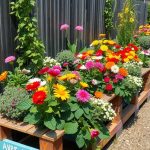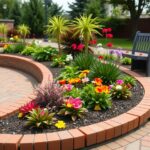If you’re looking to spruce up your garden, edging is a clever way to define your space while adding a touch of charm. From rustic stones to sleek metals, there are plenty of styles to suit any taste and budget. Check out these 31 garden edging ideas that will inspire you to create a vibrant and organized outdoor area.
Pebble and Gravel Edging

Pebble and gravel edging is a simple yet effective way to define your garden beds. It creates a natural border that can enhance the look of your outdoor space. In this image, you can see a beautiful pathway lined with pebbles, contrasting perfectly with the vibrant flowers nearby.
The use of different sizes and colors of stones adds texture and interest. This approach not only looks appealing but also helps keep weeds at bay. The gravel acts as a barrier, reducing the chances of grass spilling into your flower beds.
Another benefit of pebble and gravel edging is the drainage it provides. Water filters through the stones, helping prevent standing water in your garden. This is especially useful in heavy rain, allowing your plants to thrive without waterlogging.
When creating your own pebble and gravel edging, consider the color palette of your garden. You can choose pebbles that complement your plants or contrast nicely for a pop of visual interest. It’s a versatile option that fits various styles, from modern to rustic.
Terracotta Pot Borders
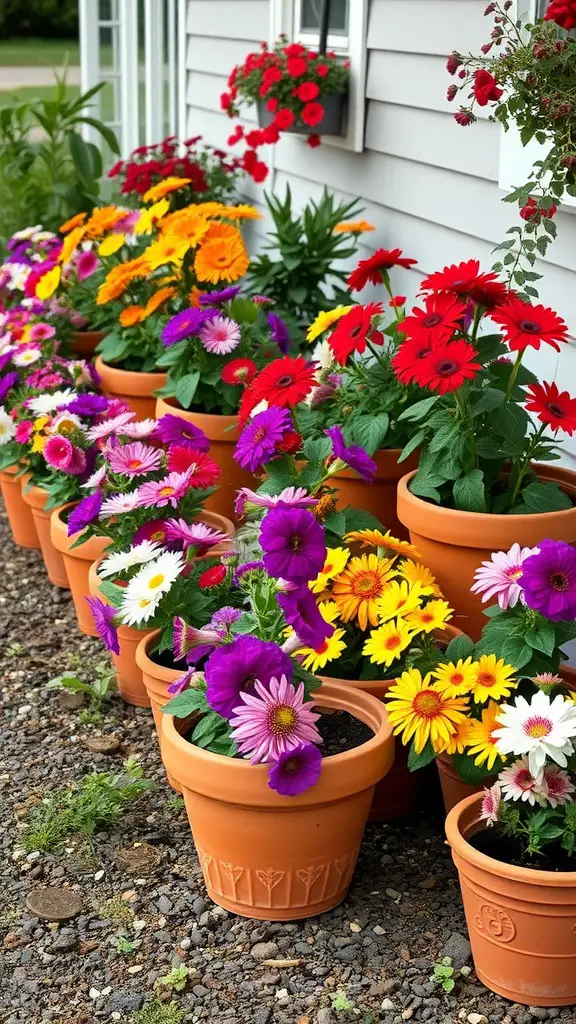
Terracotta pots can bring a warm and inviting feel to any garden. They are often used to hold vibrant flowers, as seen in the image, where colorful blooms are arranged in a neat row. This setup adds charm and definition to the garden space, making it visually appealing.
Using terracotta pots as borders is a simple way to delineate different areas of your garden. They can create a cozy feel while also serving a practical purpose. The pots can be filled with a mix of flowers, adding pops of color that can brighten up your outdoor area.
Another benefit of using terracotta pot borders is their durability. They can withstand various weather conditions and can last for many seasons. Plus, they can easily be moved around if you want to change the layout of your garden.
For those who love DIY projects, consider painting or decorating the terracotta pots to match your garden theme. This can add a personal touch and make your garden truly unique.
Overall, terracotta pot borders are a charming and functional way to edge your garden. They not only enhance the visual appeal but also allow for creativity and flexibility in your gardening design.
Brick Pathway Borders
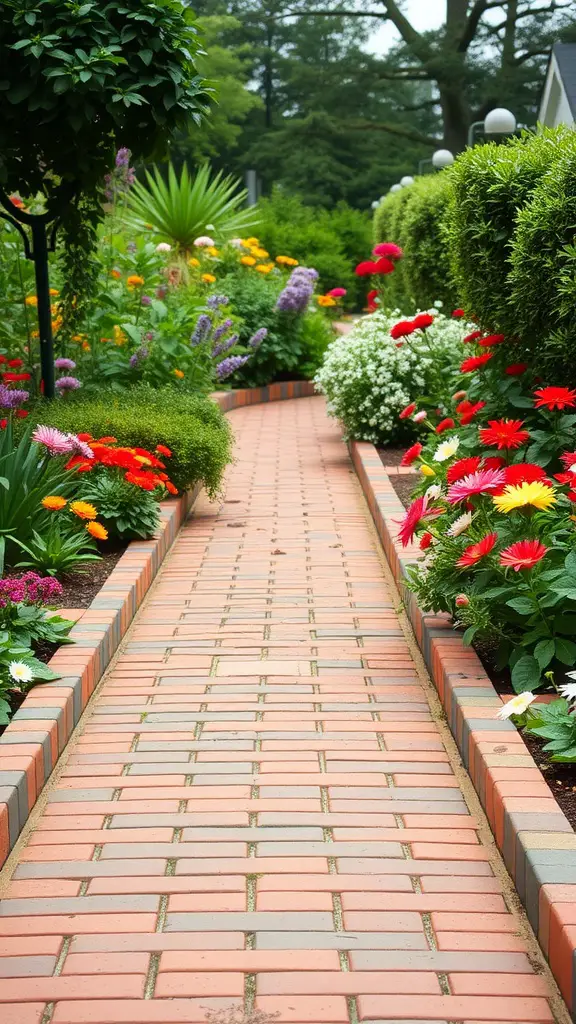
Brick pathway borders are a charming addition to any garden. They help define the space while adding a touch of elegance. The image here shows a well-maintained pathway that is both inviting and beautiful.
The bricks create a clear path through the lush greenery and vibrant flowers. The soft colors of the bricks complement the bright hues of the flowers, making each bloom stand out. This kind of edging not only enhances the aesthetic but also keeps the garden looking tidy.
Creating a brick border is relatively simple. You can start by laying down the bricks in a straight line or in a curved design, depending on your garden layout. Make sure to pack the soil well to keep the bricks in place. A nice layer of sand between the bricks can also help with drainage.
Overall, brick pathway borders are perfect for guiding guests through your garden while showcasing your beautiful plants. They offer a practical solution for keeping your garden organized, all while enhancing its visual appeal.
Metal Garden Edging
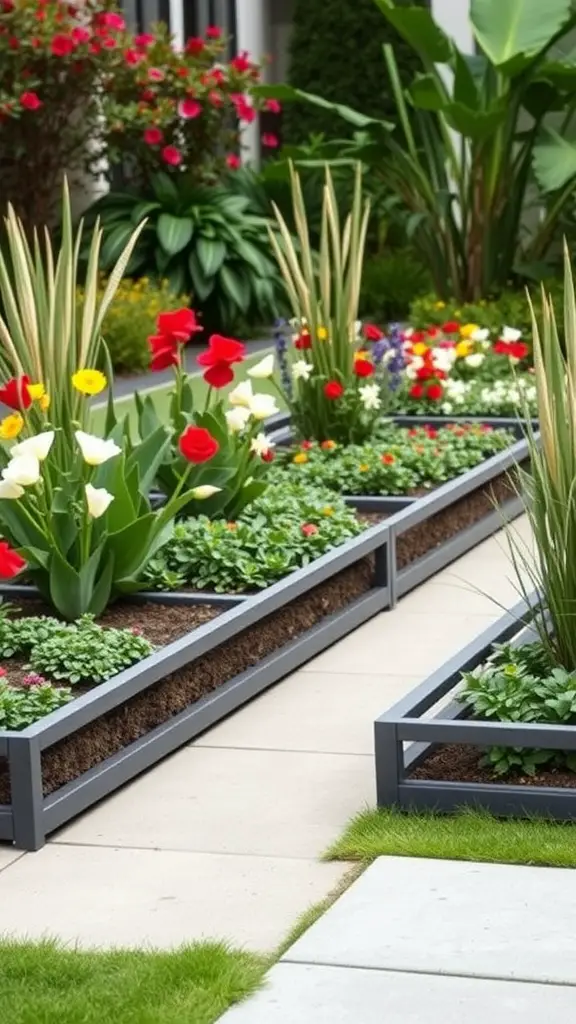
Metal garden edging can truly elevate your outdoor space. In the image, you see sleek metal borders framing flower beds filled with colorful blooms. This clean design not only keeps the soil in place but also creates a tidy appearance in your garden.
The shiny finish of the metal contrasts beautifully with the vibrant flowers and lush greenery. It’s a stylish choice that complements a wide range of garden styles. Plus, it’s durable, meaning it will last through various weather conditions without needing constant upkeep.
Using metal edging like this can help define different areas of your garden. It makes transitioning from one plant bed to another seamless. This functionality paired with its aesthetic appeal makes metal edging a smart addition to any garden layout.
Whether you prefer a modern look or something more traditional, metal edging fits right in. Its versatility ensures that it can work in various designs, from contemporary landscapes to classic cottage gardens. So, if you’re considering how to enhance your garden edges, metal edging is definitely worth exploring.
Natural Stone Borders
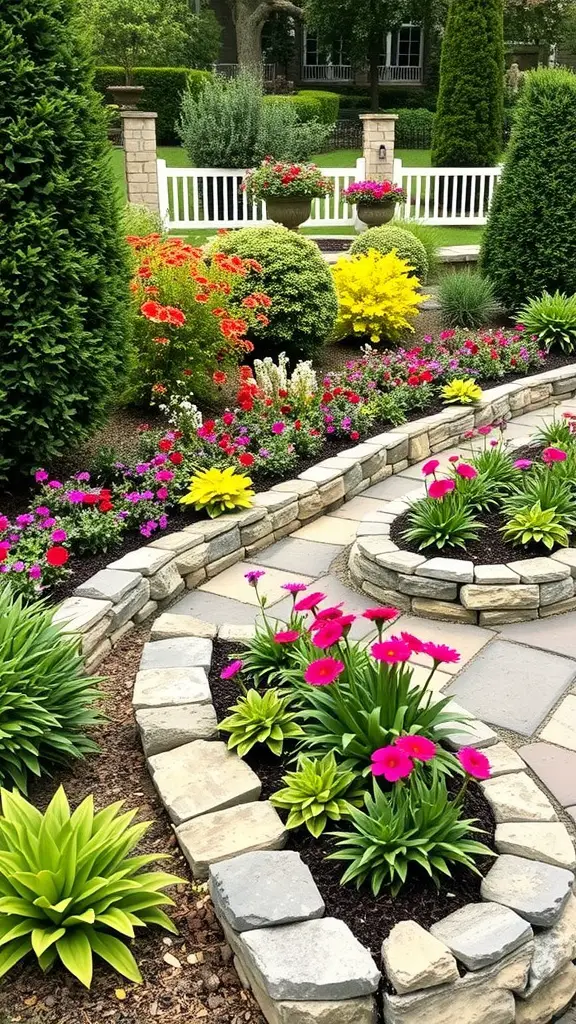
Natural stone borders can bring a rustic charm to your garden. In the image, you can see how beautifully these stones frame the flower beds. The curved edges create a soft flow that guides the eye through the landscape.
The stones provide a sturdy boundary for the vibrant plants, like the lively pink flowers and lush green foliage. This contrast highlights the beauty of both the stones and the flora. Using natural materials like stone helps gardens feel more integrated with nature.
Additionally, stone borders are practical. They help keep soil in place and prevent weeds from creeping into your flower beds. Plus, they require very little upkeep. Just a simple rinse or brush will keep them looking fresh.
Incorporating stone borders into your garden design can also add depth. The different heights and colors of the plants get enhanced by the textured surfaces of the stones. Whether you choose large boulders or smaller pebbles, each option offers a unique look and feel.
Recycled Tire Edging

Using recycled tires for garden edging is a clever way to give your garden a unique look while promoting sustainability. In the image above, you can see bright yellow flowers beautifully contrasting against the rubber tire. This setup not only adds character but also provides a functional boundary for your plants.
Tire edging is durable and can withstand various weather conditions, making it a long-lasting choice. Plus, they come with a bit of flexibility, allowing you to create curved shapes that can soften the hard lines often found in traditional garden borders.
One of the benefits of this type of edging is its cost-effectiveness. Old tires are often available for free or at a low price, making it a budget-friendly option for gardeners. Simply cut the tires into desired shapes, and you’re good to go!
Incorporating flowers, like the cheerful blooms in the image, can elevate the overall aesthetic. They not only bring color but also help in attracting pollinators. So, when you think about edging, consider how recycled tires can be both practical and visually appealing.
Cinder Block Edging
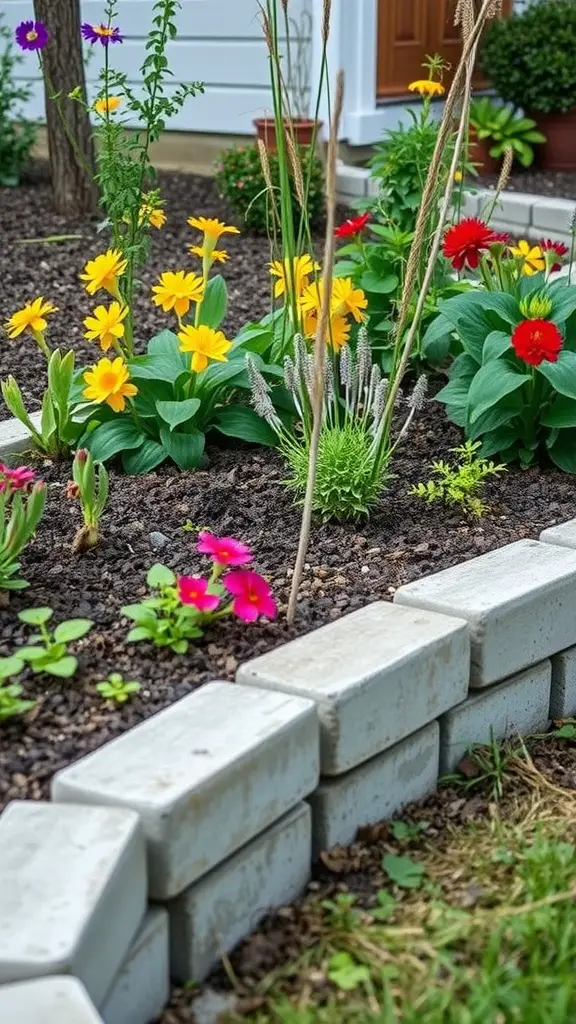
Cinder block edging is a simple yet stylish way to define garden spaces. The image shows a neat row of light gray cinder blocks surrounding a vibrant flower bed filled with colorful blooms. This type of edging not only keeps soil in place but also adds a bit of structure to your garden.
The blocks are stacked in a way that creates a low wall, which can help prevent weeds from creeping into your flower beds. You can easily customize the layout to fit the shape of your garden, whether it’s a straight line or a curved design.
One of the benefits of using cinder blocks is their durability. They can withstand weather changes without crumbling or fading. Plus, they can be painted or left in their natural state for a more rustic look. Consider planting small flowers or herbs in the gaps for a charming touch!
Overall, cinder block edging is a practical solution that enhances the beauty of your garden while serving a functional purpose. It’s a great way to get creative with your landscape design!
Wooden Garden Edging
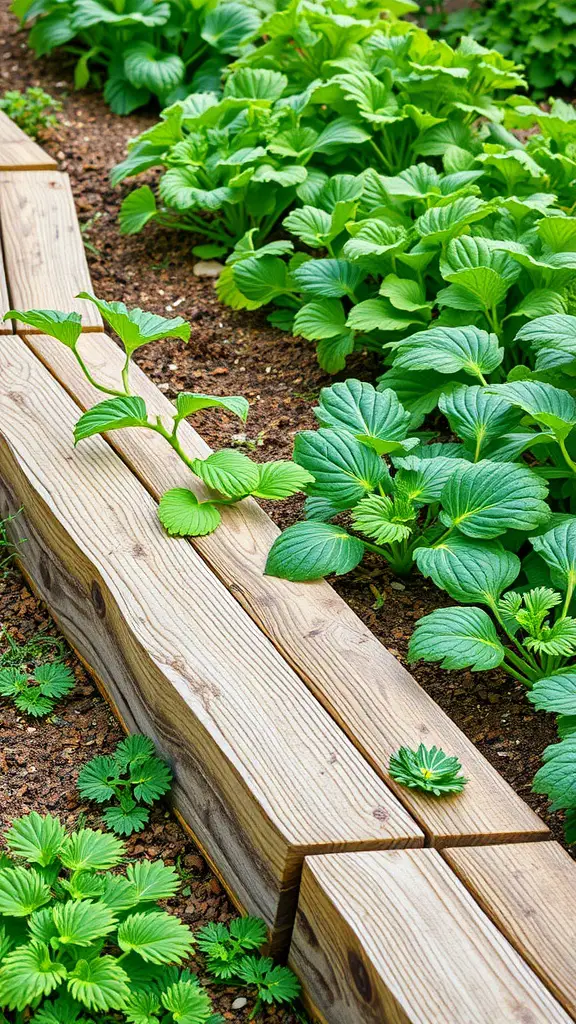
Wooden garden edging is a charming way to define your garden beds. In the image, you can see beautifully arranged wooden planks creating a clear boundary. The natural look of wood blends well with the greenery around it.
This type of edging is not just functional; it adds a rustic touch to your garden. The planks help keep soil in place and prevent grass from encroaching on your plants. It also makes it easier to maintain the garden, as you can clearly see where the garden starts and ends.
Another benefit of wooden edging is versatility. You can cut the planks to fit any shape or size you want. Whether you’re going for a straight line or a curved design, wooden edges can adapt easily. Plus, they can be stained or painted if you want a splash of color.
Additionally, the wood can be sourced sustainably, making it an eco-friendly choice. Over time, it will weather beautifully, adding character to your garden. Just be sure to choose treated wood to resist rot and pests.
Wire Fencing Borders
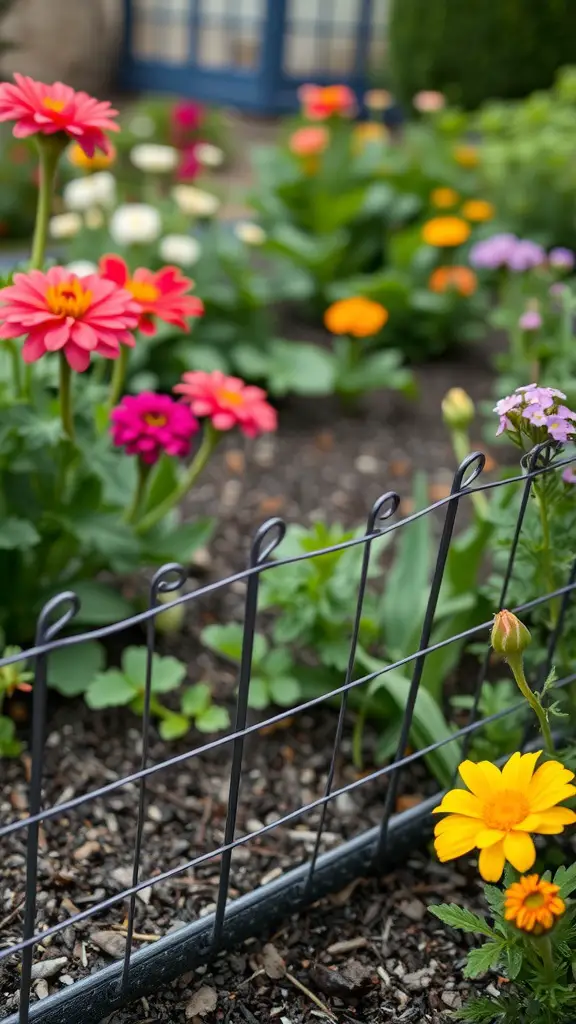
When it comes to garden edging, wire fencing is a stylish and functional option. In the image, you can see a neat wire border that beautifully frames a vibrant flower bed. The delicate design of the fencing complements the colorful blooms, adding a touch of charm to the garden.
This type of edging not only defines garden spaces but also helps to keep plants organized. The wire allows for visibility of the flowers, showcasing their colors and shapes. Plus, it’s a practical solution to keep pets or wandering feet from trampling your plants.
Choosing wire fencing can be an easy DIY project. You can find various styles, from simple to decorative designs, to match your garden aesthetic. It’s also lightweight, making installation a breeze. Just ensure you bury the bottom edge slightly to secure it in place and prevent any bending.
Overall, wire fencing borders can elevate the look of your garden while serving a practical purpose. They’re perfect for adding structure to your planting areas, enhancing the overall appeal of your outdoor space.
Bamboo Edging

Bamboo edging brings a natural touch to your garden. It’s a simple way to define spaces, whether you’re outlining a flower bed or creating a path. The bamboo sticks in this image are neatly arranged, offering a warm, organic vibe that complements various types of plants.
One of the best things about bamboo is its sustainability. It grows quickly and can be sourced responsibly, making it an eco-friendly choice. Plus, it’s lightweight yet sturdy, which means you can easily install it without much hassle.
Bamboo edging not only looks nice but also helps keep soil and mulch in place. It acts as a barrier for grass and weeds, minimizing maintenance. If you’re looking to enhance your garden’s aesthetics while keeping it tidy, consider using bamboo for a stylish and practical solution.
Living Plant Edging
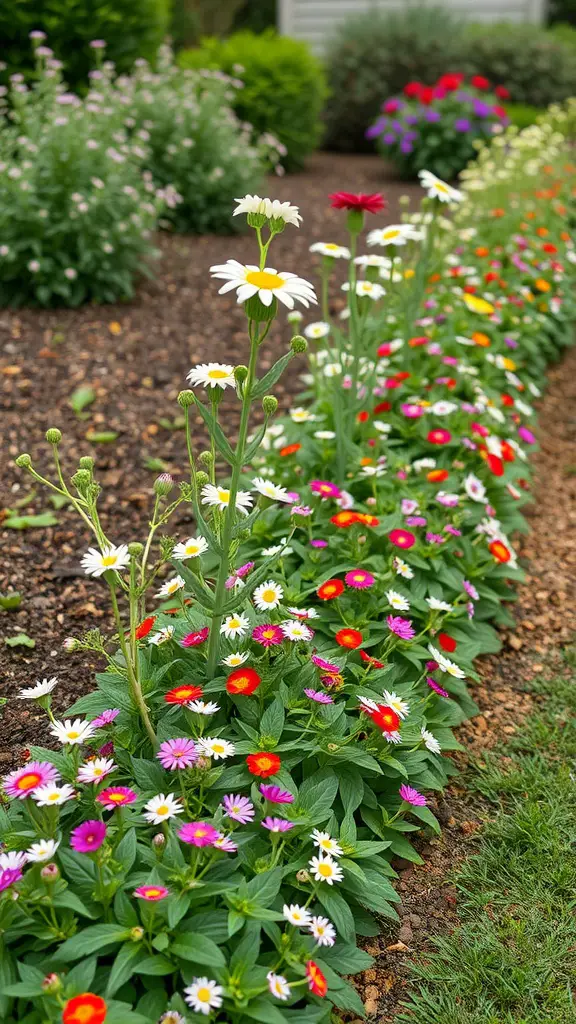
Living plant edging is a charming way to define garden spaces. Instead of traditional materials like wood or stone, why not consider using flowers? They not only provide a boundary but also add a pop of color and life to the landscape.
In the image, a vibrant row of flowers creates a lovely natural edge. The mix of daisies and colorful blooms makes it visually appealing. This type of edging can soften the hard lines of a garden bed while inviting pollinators like bees and butterflies.
Choosing the right plants is key. Opt for low-growing varieties that won’t obstruct views. Plants like petunias or marigolds work well. Also, consider the growing conditions in your yard, such as sunlight and soil type, when selecting your flowers.
Maintaining living plant edging is straightforward. Regular watering and occasional trimming will keep your flowers healthy and in shape. Plus, it’s a fun way to get hands-on in your garden. So grab your gardening gloves and dig in!
Slate Stone Edging
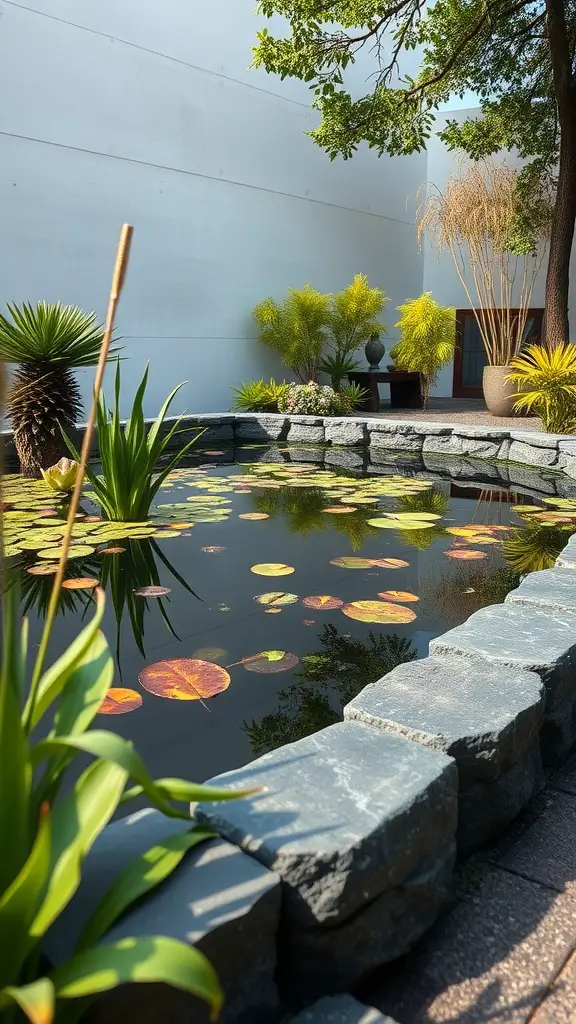
Slate stone edging is a fantastic way to define garden spaces and add a touch of sophistication. The dark, natural hues of slate create a beautiful contrast with vibrant plants and flowers. If you’re looking to enhance your outdoor space, this type of edging can complement various styles, from modern to rustic.
In the image, you can see a serene pond surrounded by slate stone borders. This not only helps to keep the area tidy but also adds a natural element that blends seamlessly with the environment. The smooth texture of slate paired with the reflective surface of the water creates a calming effect.
Slate stone is durable and can withstand the elements, making it a practical choice for any garden. It’s easy to install, and its varying shapes and sizes allow for creativity in your garden design. As seen here, it can outline pathways or water features, guiding the eye and creating a cohesive look.
Consider using slate stone edging to mark off flower beds or vegetable gardens. It not only serves a functional purpose but also elevates the overall aesthetic of your outdoor space. Plus, its earthy tones can complement any plant colors beautifully, making your garden truly inviting.
Glass Bottle Edging

Using glass bottles as garden edging is a fun and creative way to define your garden beds. This technique not only adds personality but also repurposes materials that might otherwise end up in the trash.
The image showcases a row of bottles in vibrant colors, including green, red, and blue, nestled into the soil. They create a unique boundary that stands out against the backdrop of lush plants and flowers.
To create your own glass bottle edging, gather a mix of empty bottles. You can choose different colors and sizes to add variety. Simply dig a shallow trench along the edge of your garden bed and place the bottles neck-down, ensuring they’re stable.
This type of edging is not only decorative but also functional. It helps keep soil in place and can deter some small animals from entering your garden. Plus, when sunlight hits the glass, it creates a pretty sparkle that enhances your garden’s charm.
So, if you’re looking for a budget-friendly and eco-friendly way to edge your garden, consider going with glass bottles. It’s a simple project that can give your garden a whimsical touch!
Concrete Pavers Edging
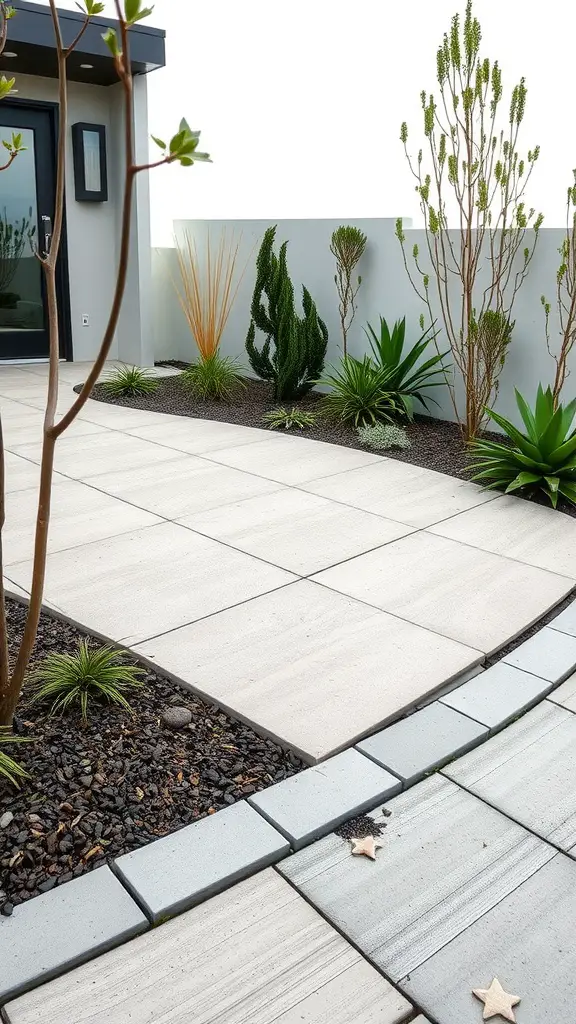
Concrete pavers can really elevate your garden’s look. In the image, you see a clean and modern layout with large concrete slabs that create a smooth pathway. These pavers not only define spaces but also serve a practical purpose by keeping soil and mulch in place.
The contrast between the light-colored pavers and the dark gravel adds depth to the design. Surrounding plants, like the spiky ones, bring in a touch of nature, making the area feel inviting. It’s a simple but effective way to separate different sections of your garden.
Using concrete pavers as edging is not just functional; it gives a polished touch to your outdoor area. You can easily create borders around flower beds or pathways, enhancing the overall structure. Plus, they’re durable, ensuring that your garden remains tidy over time.
Curved Wooden Rail Edging

Curved wooden rail edging is a charming way to define garden spaces. This type of edging adds a natural feel that blends beautifully with vibrant flower beds. The gentle curves draw the eye, making the garden look inviting and well-kept.
The design often features wooden slats that allow for airflow and drainage, which is beneficial for plant health. The warm tones of wood complement colorful flowers like zinnias and daisies, enhancing their beauty. It’s a simple yet effective way to organize your garden.
Installing curved wooden rail edging is also a fun DIY project. You can customize it to fit the specific shape of your garden flowers. Whether you want a tight curve or a gentle bend, this edging option gives you the freedom to design your outdoor space as you like.
This type of edging not only keeps plants neatly contained but also helps prevent soil erosion. It’s practical and adds a soft, rustic charm that makes any garden feel more welcoming.
Mulch Edging
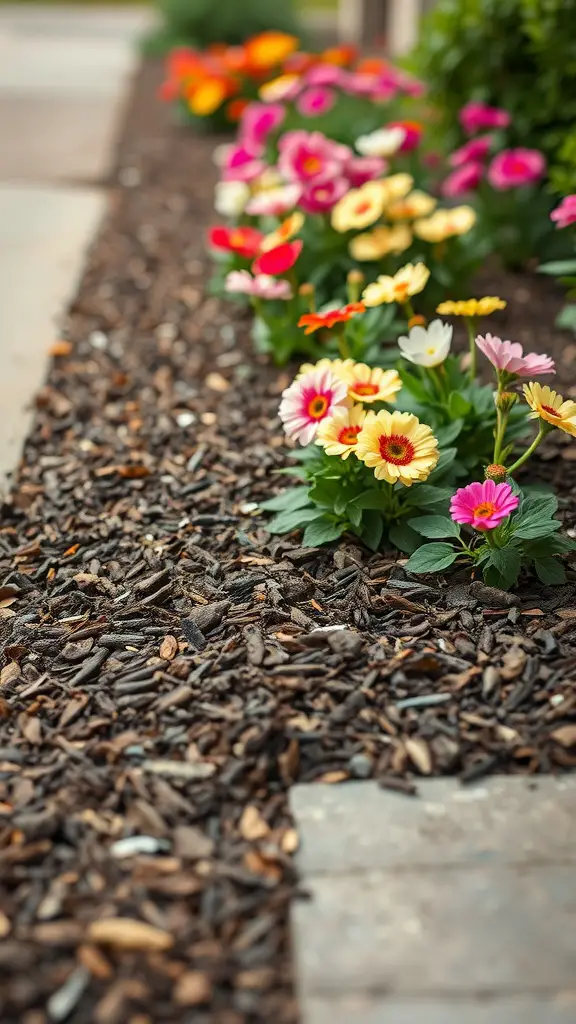
Mulch edging is a simple yet effective way to define your garden beds while adding a touch of beauty. In the image, you can see vibrant flowers peeking through a rich layer of mulch. This contrast creates a visually appealing border that draws the eye.
Using mulch not only enhances the aesthetic of your garden but also serves practical purposes. It helps retain moisture in the soil and reduces weed growth, making maintenance easier. Plus, it gradually breaks down, enriching the soil over time.
There are various types of mulch to choose from, including wood chips, bark, and shredded leaves. Each type offers a different look and feel, allowing you to customize your garden’s charm. As seen in the picture, the dark mulch contrasts nicely with the bright colors of the flowers, creating a warm and inviting atmosphere.
When installing mulch edging, ensure you apply a thick layer to provide effective coverage. This can be a fun weekend project that significantly enhances your outdoor space. So grab your gardening gloves and get started!
Rustic Log Edging
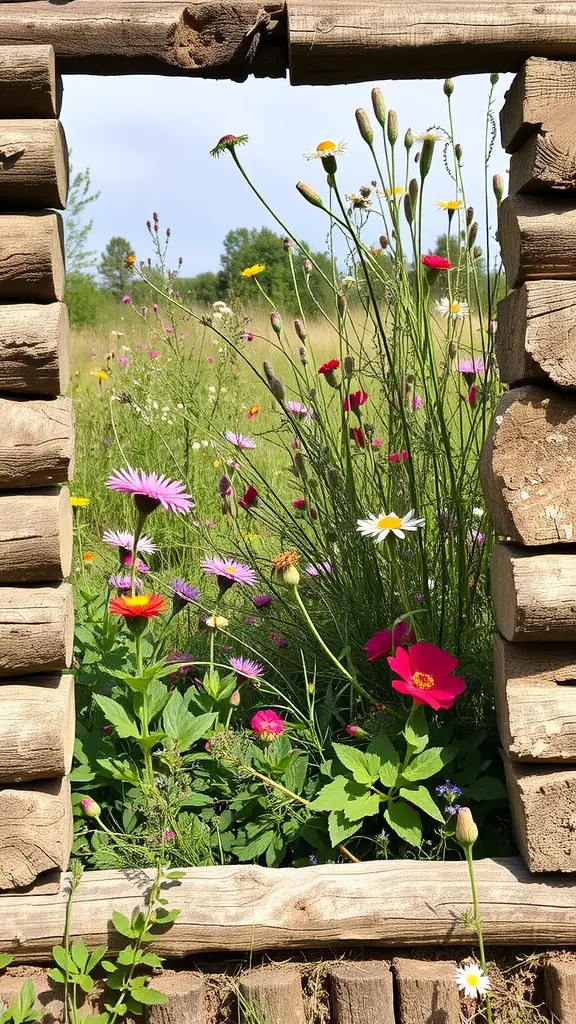
Rustic log edging adds a charming touch to any garden. It creates a natural boundary that blends seamlessly with the surrounding landscape. The use of logs not only defines the space but also enhances the rustic vibe of your garden.
In the image, you can see a lovely arrangement of colorful flowers framed by sturdy logs. This design showcases how effective log edging can be in highlighting your blooms. The contrast of the vibrant flowers against the earthy tones of the wood creates a warm and inviting atmosphere.
Log edging is also practical. It helps keep soil and mulch contained, preventing them from spilling into walkways. This simple solution is easy to install and can be adjusted as your garden evolves.
If you’re considering this style, look for logs that are untreated to avoid harmful chemicals in your soil. Additionally, you can choose logs of varying heights to create a more dynamic look. It’s a straightforward project that can be a fun DIY endeavor.
Colorful Mosaic Edging
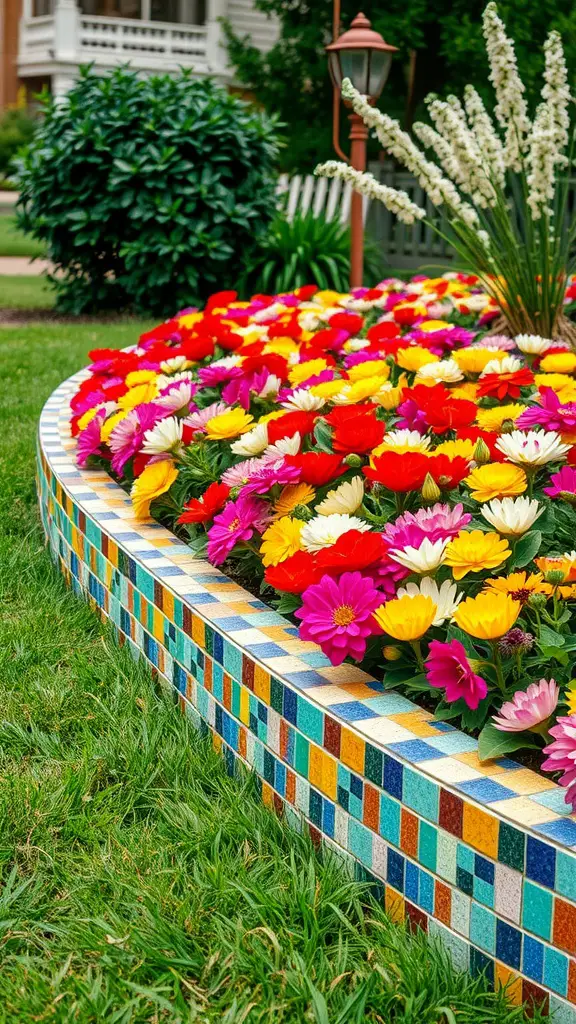
Colorful mosaic edging can transform any garden into a vibrant space. The image showcases a beautifully arranged flower bed, bordered by a stunning mosaic of tiles. This type of edging not only defines the area but adds a splash of color that harmonizes with the flowers.
The bright reds, yellows, and pinks of the flowers create a cheerful atmosphere. Pairing this with the colorful tiles enhances the beauty of the garden, making it an eye-catching feature. The tiles are arranged in a playful pattern, drawing attention and inviting visitors to explore the garden further.
Using mosaic tiles for garden edging is a fun way to express your creativity. You can choose tiles that match your flowers or go for a contrasting look. Either way, it makes your garden stand out. Plus, this type of edging is durable and can withstand the elements, ensuring your garden looks good season after season.
So, if you’re looking to add some flair to your outdoor space, colorful mosaic edging is a delightful option. It’s a simple way to elevate the look of your garden while keeping things organized and neat.
Raised Bed Edging

Raised bed edging is a practical way to define your garden space while enhancing its look. In the image, we see a well-constructed raised bed filled with lush green plants. The wooden frame provides a sturdy boundary, keeping soil in place and preventing weeds from invading your garden.
This kind of edging is not just functional; it adds a charming touch to your garden design. The clean lines of the raised bed contrast beautifully with the vibrant plants, creating a visually pleasing arrangement. The choice of materials can vary—from natural wood to more modern options like stone or metal—allowing you to tailor it to your style.
Raised beds also improve drainage and soil quality, making it easier to grow healthy plants. Whether you’re cultivating vegetables, herbs, or flowers, the right edging can make all the difference. Plus, it can help to keep your gardening efforts neatly contained, making maintenance simpler.
Faux Stone Panels Edging
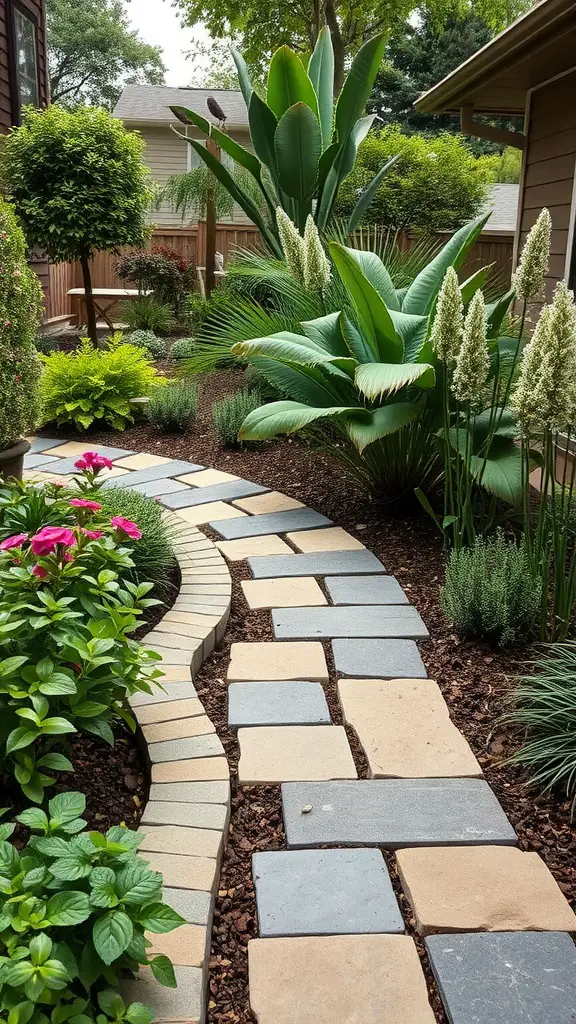
Faux stone panels are a clever way to add charm to your garden while keeping things neat. This type of edging offers a natural look without the hefty price tag of real stone. It’s lightweight and easy to install, making it a popular choice for those looking to enhance their outdoor space.
The image illustrates how faux stone panels can blend seamlessly with lush greenery and vibrant flowers. The winding path, bordered by these panels, creates a welcoming atmosphere, encouraging you to explore every nook of the garden. The combination of stone and plants adds texture and depth, making the garden feel more vibrant.
One of the best things about faux stone is its versatility. You can find it in different colors and patterns, allowing you to match it with your overall garden theme. Pairing these panels with colorful flowers and greenery, like in the image, adds life and energy to your outdoor area.
Overall, using faux stone panels for edging is a smart way to define your garden beds or walkways. It not only enhances the aesthetic but also keeps your plants tidy. If you’re looking to do some gardening this season, consider how faux stones can elevate your space.
Shells and Sand Edging
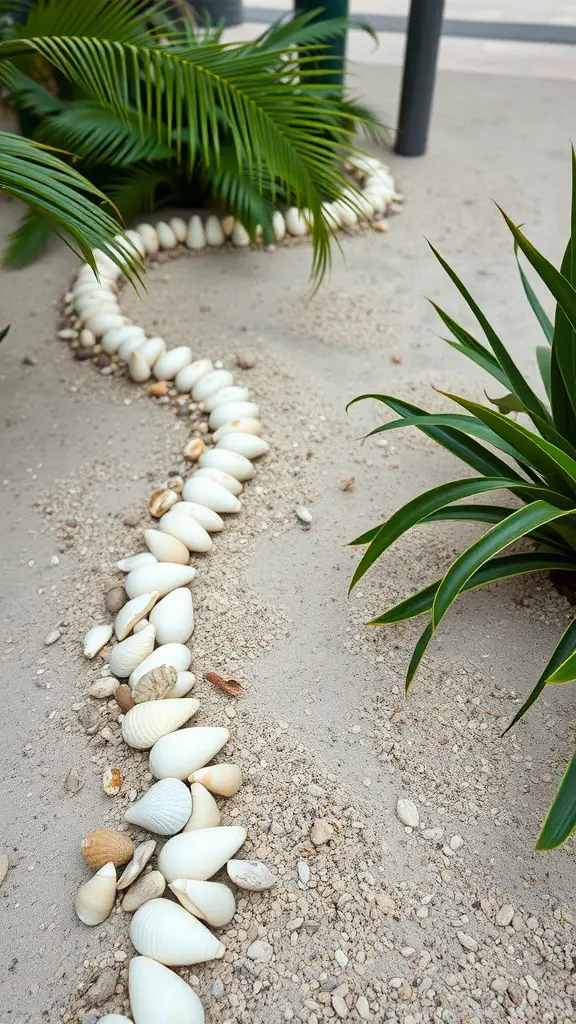
Using shells and sand for garden edging creates a unique and inviting look. In the image, you can see a lovely path made from white shells. These shells are arranged in a gentle curve, surrounded by soft sand. It’s a simple yet eye-catching design that adds a beachy vibe to any garden.
This type of edging is not just about looks; it can also help define areas in your garden. The shells create a clear border between different plants or sections, making your garden feel more organized. Plus, the sandy backdrop complements the shells beautifully.
If you’re considering this idea, you can easily collect shells during a beach trip or purchase them from a craft store. Just lay them out in your desired shape and fill in the gaps with sand or gravel. It’s a fun project that allows you to get creative with your garden design!
Garden Fence Edging

Garden fence edging adds a charming touch to any outdoor space. In the image above, a classic white picket fence frames a beautiful garden filled with vibrant flowers. The fence not only defines the garden area but also enhances its overall appeal.
Using a fence as edging helps keep your garden neat and organized. It provides a clear boundary, separating your flower beds from the lawn. In this case, the colorful blossoms, like pink and yellow flowers, contrast nicely with the white fence, making the garden pop.
Another benefit of garden fence edging is the variety it offers. From wooden pickets to metal designs, you can choose a style that fits your home’s aesthetic. Additionally, fences can serve as a support structure for climbing plants, adding even more life to your garden space.
Take inspiration from this image and consider how a simple fence can elevate your garden. It’s all about creating a welcoming environment that you can enjoy throughout the seasons.
Lattice Work Borders
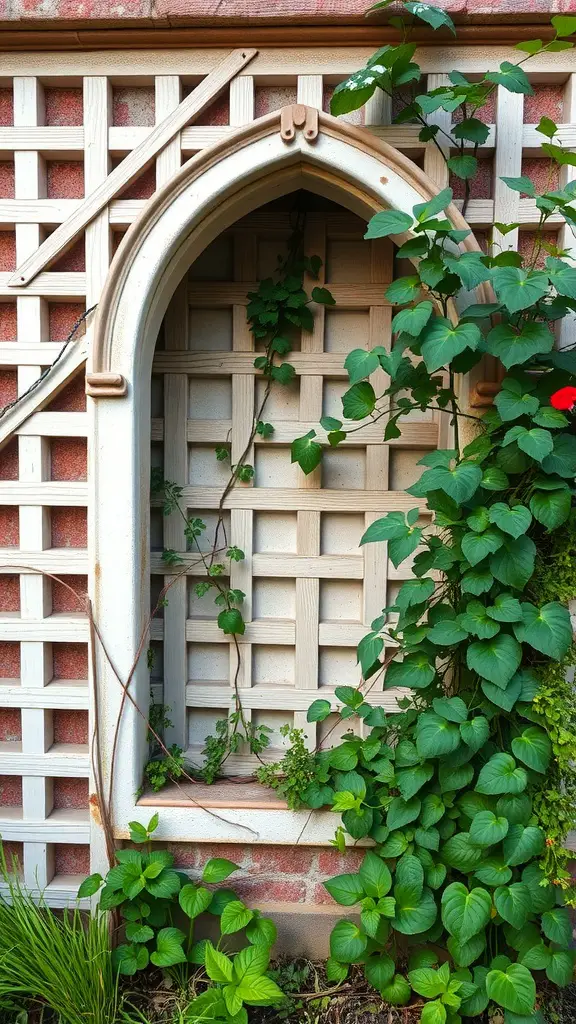
Lattice work borders can add a unique touch to your garden. They create a beautiful frame for climbing plants and can enhance the overall design of your outdoor space.
In the image, we see a charming lattice structure that offers both support for vines and an interesting visual element. The wooden lattice contrasts nicely with the vibrant green leaves, making the natural beauty of the plants stand out.
This type of border not only defines garden areas but also allows for creativity. You can paint the lattice in different colors or even use different materials to match your garden style. Lattice borders can serve as a backdrop for flowers or as a decorative piece on their own, blending seamlessly with the lush greenery.
Using lattice as a border can also provide privacy and create cozy nooks in your garden. Incorporating climbing plants like ivy or roses can add even more character. It’s a simple way to elevate your garden’s aesthetics!
Stepping Stone Edging

Stepping stone edging can add a charming touch to any garden path. The image shows a pathway lined with natural stone slabs, creating a clear route through a lush garden. The stones are unevenly shaped, which adds a casual, rustic vibe.
On either side of the pathway, vibrant green foliage peeks out, softening the edges of the stones. This blend of hardscape and softscape makes the walkway feel inviting and connected to nature. The occasional burst of color from nearby flowers enhances the visual appeal.
Using stepping stones for edging not only defines the path but also helps to manage foot traffic in your garden. It encourages visitors to walk along the designated route, keeping your plants safe and thriving. This is a simple yet effective way to maintain both beauty and functionality in your outdoor space.
Painted Wooden Planks Edging
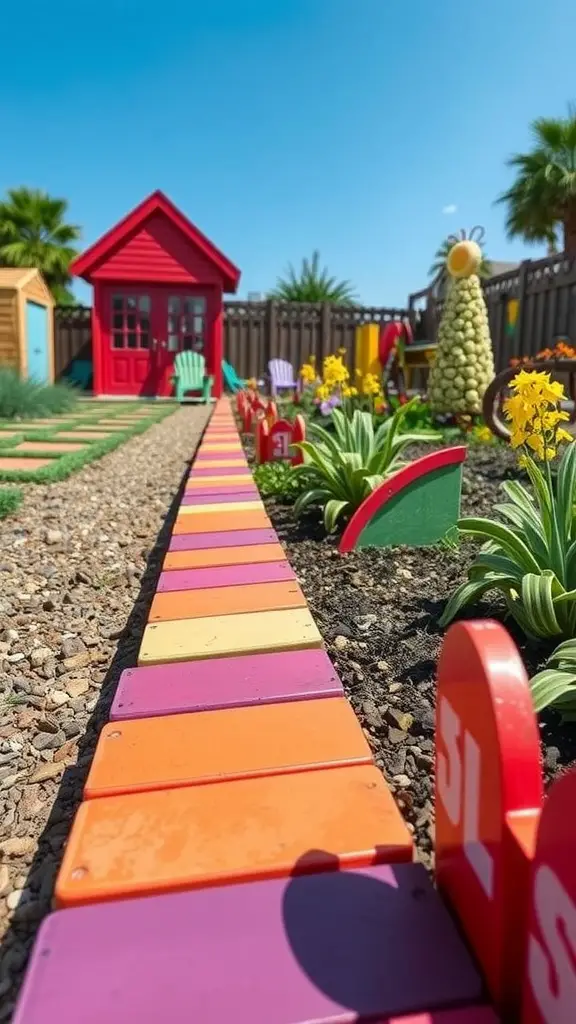
Painted wooden planks are a cheerful and creative way to edge your garden. In this image, the vibrant colors of the planks stand out, guiding the eye toward the charming red shed in the background. This kind of edging not only defines spaces but also adds a playful touch to your outdoor area.
Using wooden planks can be an easy DIY project. You can customize colors to match your garden theme or personal style. In this setup, shades of purple, orange, and yellow are used to create a lively pathway, making a fun statement.
The garden itself is lively, with colorful flowers and quirky decorations. This invites visitors to explore the space. The painted planks act as a visual path, leading to various spots within the garden, encouraging people to wander through the blooms and enjoy the scenery.
Overall, painted wooden planks are not just functional; they bring character and charm to any garden. If you’re looking for a way to brighten up your outdoor spaces, this simple idea might just be the inspiration you need!
Hedge Plant Borders

Using hedge plants as borders can really transform your garden space. The image showcases a beautiful, neatly trimmed hedge that curves along a path, providing both structure and charm to the layout.
The vibrant green leaves create a lively contrast against the brick pathway, adding a refreshing touch to the overall aesthetic. This type of border not only delineates spaces within your garden but also offers a soft, natural look that can complement various styles.
Hedge plants can also act as a privacy screen, helping to create intimate outdoor areas. Plus, they can be shaped and trimmed to suit your design preferences. Whether you prefer a more formal look or something more relaxed, a well-maintained hedge can do the trick.
Incorporating hedge plant borders is a practical choice too. Many hedge varieties are relatively low maintenance and can thrive in various conditions, making them an easy addition to your garden design.
Tree Trunk Edging
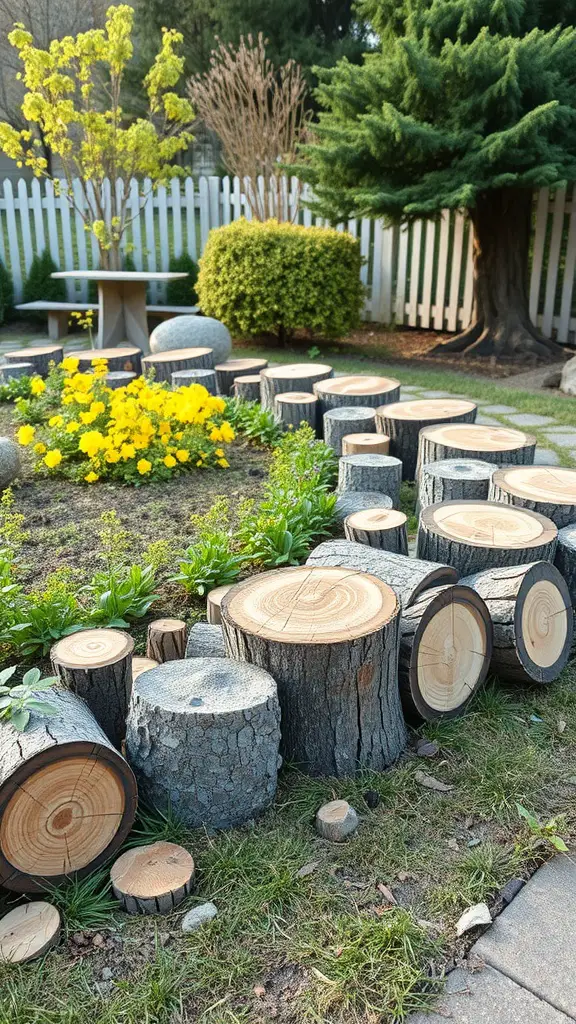
Using tree trunks as garden edging is a charming way to define your garden beds. This method brings a natural, rustic feel to your outdoor space. The image showcases various pieces of tree trunks arranged around a flower bed filled with vibrant yellow flowers. The trunks vary in size, creating an interesting visual texture.
Not only does tree trunk edging look lovely, but it also offers practical benefits. It helps to keep soil and mulch contained while providing a clear boundary between different areas of your garden. Plus, the natural materials blend seamlessly with the surrounding plants and trees, enhancing the overall aesthetic.
Maintaining this type of edging is easy. Regularly check for signs of rot or insect activity. You can also treat the wood to extend its life. This approach not only adds beauty but also recycles materials from your garden.
So, if you’re looking for a simple yet effective way to spruce up your yard, consider tree trunk edging. It’s a delightful option that encourages a rustic vibe while keeping your garden organized.
Colorful Plastic Edging

Adding colorful plastic edging to your garden can really brighten up the space. This type of edging is not only eye-catching but also functional. You can see in the image how the vibrant colors create a fun and playful atmosphere, making the garden feel inviting.
The plastic edging shapes the garden beds clearly, separating them from the walkways. This keeps the mulch and soil contained while giving a defined look. The bright colors, like red and orange, pop against the soil and greenery, making the plants stand out even more.
Another advantage of plastic edging is its durability. It can withstand various weather conditions without fading. Plus, it’s lightweight, so you can easily install it yourself without needing heavy tools. For anyone looking to add a splash of color and maintain order in their yard, colorful plastic edging is a solid choice.
Concrete Block Edging
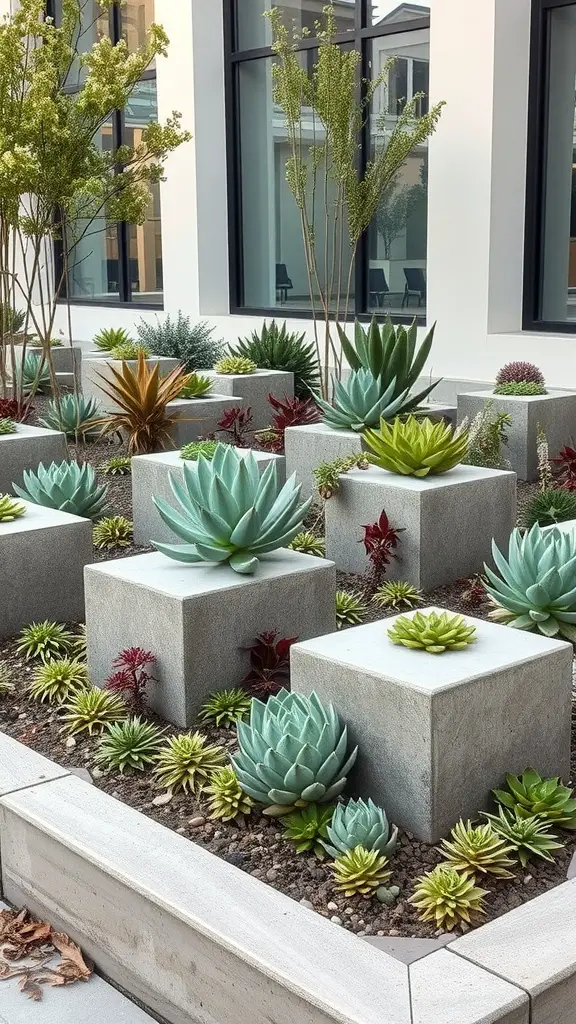
When it comes to garden edging, concrete blocks can add a unique touch. In this image, you can see a charming arrangement of succulents surrounded by concrete blocks. The blocks not only define the garden beds but also create a modern aesthetic that complements the greenery.
Concrete block edging is durable and versatile. You can stack them in various configurations or use them as flat borders. This flexibility allows you to customize your garden layout easily. Plus, they provide a clean line that separates different plant zones, making the garden look organized.
The plants in the image, which include various succulents, thrive in this setup. Their vibrant greens and blues pop against the gray of the concrete. This combination enhances the visual appeal of any outdoor space.
Another advantage of concrete block edging is its low maintenance. Unlike wood, it won’t rot or warp, ensuring that your garden remains tidy with minimal effort. You can also paint or decorate the blocks for an added personal touch.
Overall, concrete block edging not only fulfills a practical purpose but also enhances the beauty of your garden. It’s a stylish solution that works well with many plant types and designs, making it a great choice for any gardening enthusiast.
Fencing with Climbing Plants

Using climbing plants to enhance your fencing can add a lush, vibrant touch to your garden. In this image, you can see how green vines gracefully weave up a wooden fence, creating a natural border that’s both inviting and serene.
The combination of sturdy wood and lively greenery not only beautifies the space but also provides a bit of privacy. Climbing plants like ivies or morning glories can transform a plain fence into a stunning backdrop for your garden.
This approach is not just about aesthetics. Climbing plants can attract beneficial insects and provide a habitat for birds. So, while you enhance your garden’s appearance, you’re also supporting local wildlife. It’s a win-win situation!
To get started, choose climbing plants that suit your garden’s climate. Ensure your fence has the necessary support for the plants to thrive. Regular pruning and some care will keep your fence looking vibrant and healthy throughout the seasons.
Rustic Wooden Log Edging

Using rustic wooden log edging in your garden can create a warm and inviting space. The natural look of logs blends well with vibrant flowers, making your garden feel cozy and approachable.
The log edging in this image frames a flower bed filled with colorful blooms. The mix of yellows, pinks, and purples stands out beautifully against the earthy tones of the wood. This design not only defines the planting area but also adds texture and interest to the landscape.
Wooden log edging is versatile and can be used in various styles of gardens. Whether you have a modern garden or a more traditional space, logs can enhance the overall aesthetic. You can easily find logs in local lumber yards or even use reclaimed wood for a more sustainable option.
Setting up log edging is a fun DIY project. Simply arrange the logs to form a border around your garden bed. You can even layer them for added height and dimension. This rustic touch invites a relaxed vibe and can make any garden feel more inviting.

